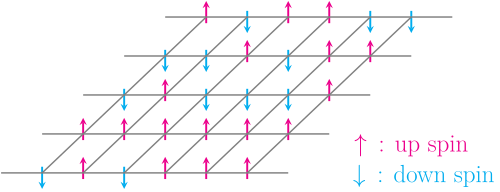#Lorenz Driven Operationally Deterministic Ising Model
#Please cite me for credit if you are planning to use my code
#Operation:
# Only the initial state is randomized. all else (core functions) operates deterministically.
# Here we deviate from the traditional Ising Model which are probabilistic, stochastic in operation:
#X(t),Y(t),Z(t) are coupled through a system of continuous non-linear differential equations.
# raw Y(t) -> used to select sites.
# normalized X(t) -> used to define spin flip conditions.
# raw Z(t) + forcing -> equation where we add our forcing component (forcing = 0 if you want pattern formation to occur)
# The free parameters of the Lorenz equation(r,s,b) are material specific and temperature independent properties of the material
# which I aptly call "spin-sensivity parameters" of a material on which the experiment is being conducted.
# Model Motivation & Model Outcome:
#The goal here is to bridge the gap between theory and practice of solid state physics by abandoning random.random()
#for the internal operations of the Ising model.
#The Ising Model is an ontologically deterministic spin system, but we are limited in
#knowing the initial conditions due to finite precision from our measurement instruments. Different potential patterns that emerge vary.
#depending on perturbing our inputs which we simulate due to said limitations in the knowledge of the initial condition of
#the system.These are extrinsic limitations. In addition the model has built structural limitations that it acknowledges:
#computers have finite resolution and time steps despite the Lorenz model being innately continuous rather than discrete
#.So our model reflects this intrinsic limitation and should provide fruitful study for how extrinsic and intrinsic
#limitations interact with one another in limiting predictability of the exact patterns formed in experiment.
#the coupled equations in real life. The coupled nature of the equations in addition to this intrinsic limitation with delta #time and fidelity could also give the model more utility to the modeler over simplistic substitution of random.random with #one dimensional discrete chaotic map where time steps are discrete f: x(t) -> x(t+1) whereas my model can do outputs for t+0.001.
# The consequence being that different pattern formation appears "stochastic" due to limitations in knowledge of the initial conditions.
#At the same time we have a "know how" that some kind of pattern of spin 'up' and 'down' will eventually emerge due to #dropping temperature.
#when you add a forcing onto Z you are altering the geometry of the attractor and thus altering the effect of the spin-#sensitivity parameters on the spin of the material on it. You consider it akin to chemical or physical alteration of a #material. This means we may be able to study the Ising with time dependent forcing with reversible alterations of the material
#Potential Numerical Advantages:
# pre-packaged inputs would offer and speed and predictability in computation over random.random() operations.
import numpy as np
import matplotlib.pyplot as plt
from decimal import Decimal, getcontext, ROUND_HALF_UP
def lorenz_step(state, dt=0.01, s=15, r=23, b=2):
x, y, z = state
x_dot = s * (y - x)
y_dot = r * x - y - x * z
z_dot = x * y - b * z
new_state = np.array([x + x_dot * dt, y + y_dot * dt, z + z_dot * dt])
return new_state
class LorenzRNG:
def __init__(self, initial_state=(0.0, 1.0, 1.05), dt=0.01, buffer_size=1000, skip_transient=500):
self.state = np.array(initial_state)
self.dt = dt
self.x_buffer = []
self.transient_counter = 0
self.skip_transient = skip_transient
self.buffer_size = buffer_size
def next(self):
self.state = lorenz_step(self.state, self.dt)
x, y, _ = self.state
if self.transient_counter < self.skip_transient:
self.transient_counter += 1
return 0.5, y
self.x_buffer.append(x)
if len(self.x_buffer) > self.buffer_size:
self.x_buffer.pop(0)
x_min = min(self.x_buffer)
x_max = max(self.x_buffer)
if x_max != x_min:
x_norm = (x - x_min) / (x_max - x_min)
else:
x_norm = 0.5
x_norm = np.clip(x_norm, 0, 1)
return x_norm, y
XMAX, YMAX = 50, 50
N = XMAX * YMAX
def delta_energy(x, y, grid):
return grid[x, y] * (
grid[(x + 1) % XMAX, y] + grid[(x - 1) % XMAX, y] +
grid[x, (y + 1) % YMAX] + grid[x, (y - 1) % YMAX]
)
def switch_spin(x, y, grid):
grid[x, y] *= -1
def grid_with_finder(rows, columns, fidelity, target_num):
getcontext().prec = 28
getcontext().rounding = ROUND_HALF_UP
fidelity_decimal = Decimal(str(fidelity))
target_decimal = Decimal(str(target_num))
grid_max = rows * columns * fidelity_decimal
if grid_max != 0:
adjusted_target = (target_decimal % grid_max) if target_decimal >= 0 else (grid_max - (abs(target_decimal) % grid_max))
else:
adjusted_target = Decimal('0')
grid = []
current_value = Decimal('0')
for y in range(rows):
row = []
for x in range(columns):
wrapped_value = current_value % grid_max if grid_max != 0 else current_value
quantized_value = wrapped_value.quantize(fidelity_decimal)
row.append(quantized_value)
current_value += fidelity_decimal
if y % 2 == 1:
row.reverse()
grid.insert(0, row)
closest = None
min_diff = float('inf')
closest_x, closest_y = -1, -1
for y in range(rows):
for x in range(columns):
diff = abs(grid[y][x] - adjusted_target)
if diff < min_diff:
min_diff = diff
closest = grid[y][x]
closest_x, closest_y = x, y
return grid, closest, (closest_x, rows - 1 - closest_y), adjusted_target
def metropolis_step(grid, temperature, lorenz_rng, scaling_factor=0.153):
x_norm, raw_y = lorenz_rng.next()
_, _, (x, y), _ = grid_with_finder(XMAX, YMAX, scaling_factor, raw_y)
dE = delta_energy(x, y, grid)
if dE <= 0:
switch_spin(x, y, grid)
else:
if x_norm < np.exp(-2 * dE / temperature):
switch_spin(x, y, grid)
def temperature_schedule(step, total_steps, T_start, T_end):
return T_end + (T_start - T_end) * np.exp(-5 * step / total_steps)
def run_simulation_with_snapshots(T_start, T_end, snapshot_steps, lorenz_initial_state, scaling_factor=0.153, initial_grid=None):
lorenz_rng = LorenzRNG(initial_state=lorenz_initial_state, dt=0.01)
if initial_grid is None:
grid = np.random.choice([-1, 1], size=(XMAX, YMAX))
else:
grid = np.copy(initial_grid)
snapshots = {}
total_steps = max(snapshot_steps)
for step in range(1, total_steps + 1):
temperature = temperature_schedule(step, total_steps, T_start, T_end)
for _ in range(XMAX * YMAX):
metropolis_step(grid, temperature, lorenz_rng, scaling_factor=scaling_factor)
if step in snapshot_steps:
snapshots[step] = np.copy(grid)
return snapshots
np.random.seed(42)
initial_grid = np.random.choice([-1, 1], size=(XMAX, YMAX))
fixed_initial_condition = (0.15, 2.32, 6.04)
scaling_factors = [0.0001]
snapshot_steps = [1, 2, 3, 4, 5, 6, 7, 8, 9, 10]
T_start = 100
T_end = 0.1
fig, axes = plt.subplots(len(scaling_factors), len(snapshot_steps), figsize=(16, 3 * len(scaling_factors)))
for i, scale in enumerate(scaling_factors):
snapshots = run_simulation_with_snapshots(
T_start, T_end, snapshot_steps, fixed_initial_condition,
scaling_factor=scale,
initial_grid=initial_grid
)
for j, step in enumerate(snapshot_steps):
ax = axes[i, j] if len(scaling_factors) > 1 else axes[j]
ax.imshow(snapshots[step], cmap='gray', interpolation='nearest')
ax.set_title(f"Step {step}")
ax.axis('off')
plt.suptitle(f"Lorenz Driven Operationally Deterministic Ising Model. Scale: {scale}", fontsize=18)
plt.tight_layout(rect=[0, 0, 1, 0.96])
plt.show()


















